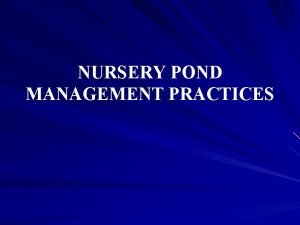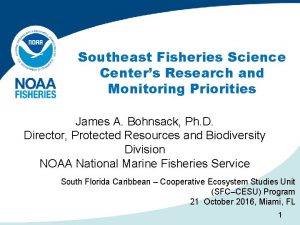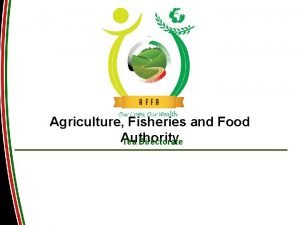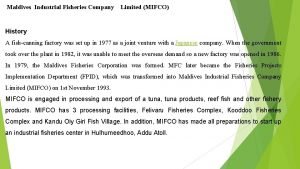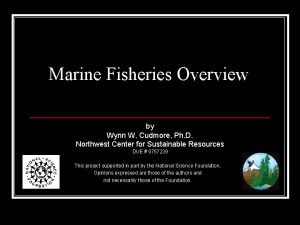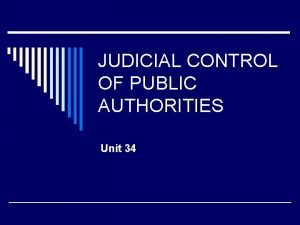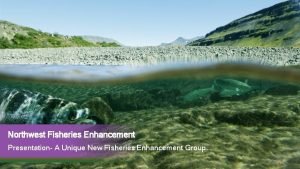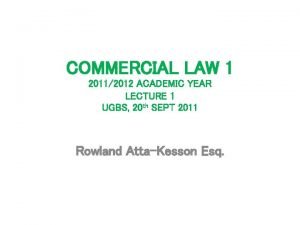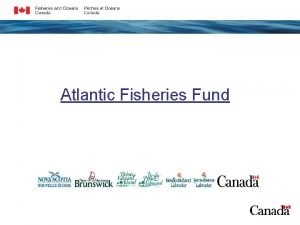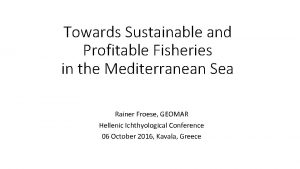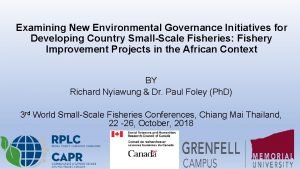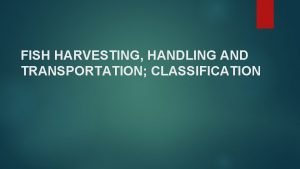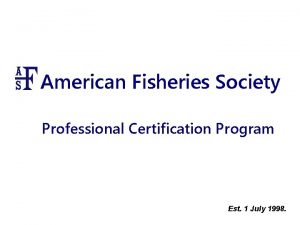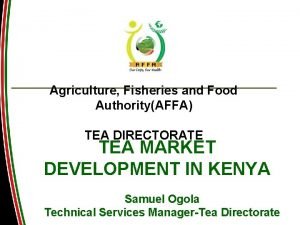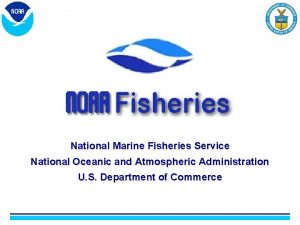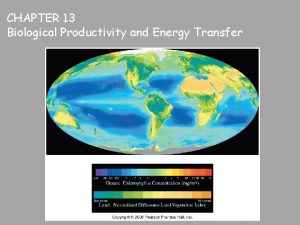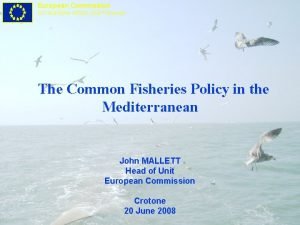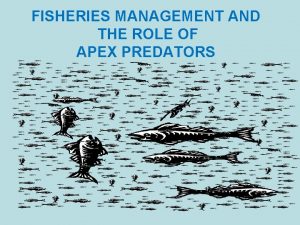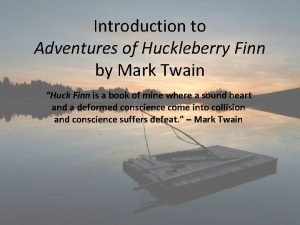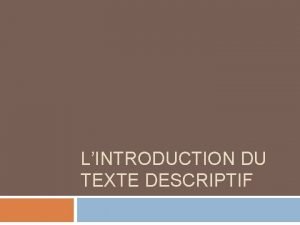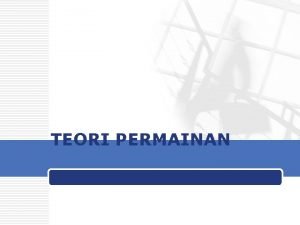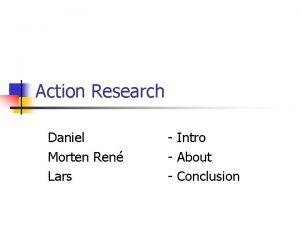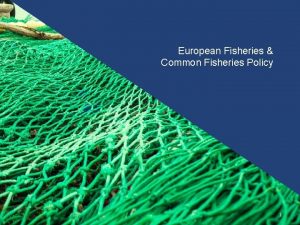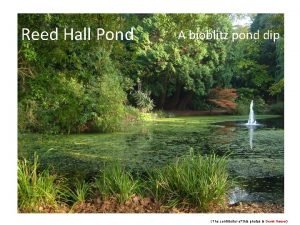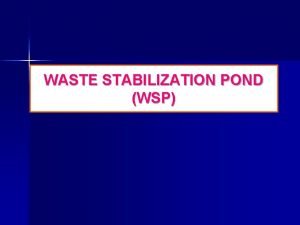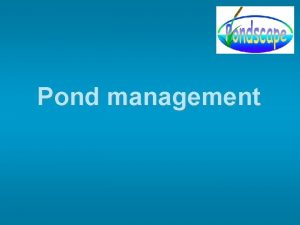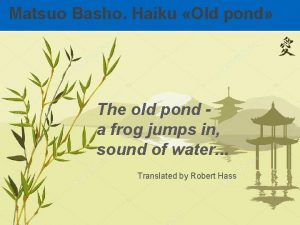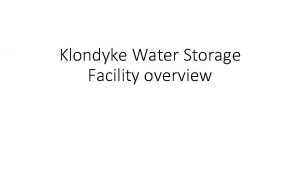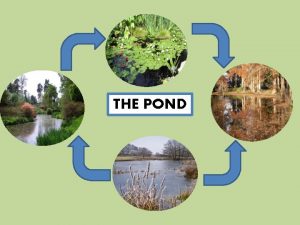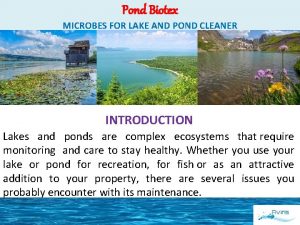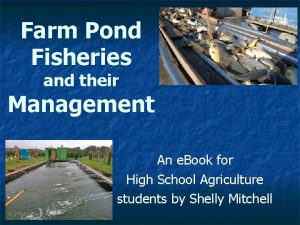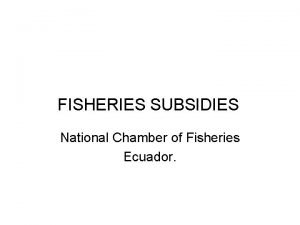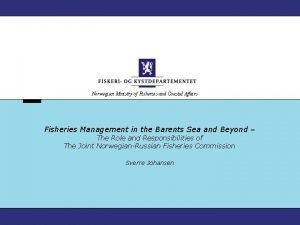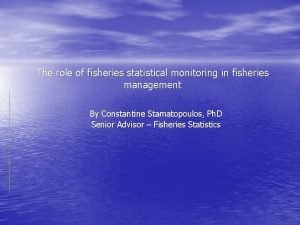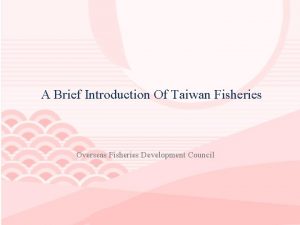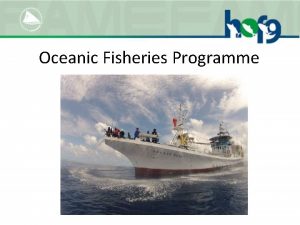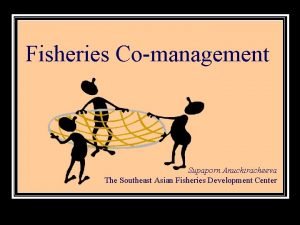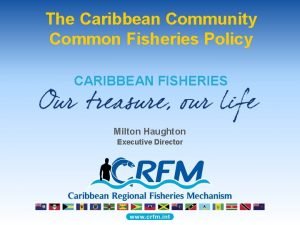An Intro to Managing Pond Fisheries Ohio Pond

































- Slides: 33

An Intro to Managing Pond Fisheries: Ohio Pond Clinics 2017 Eugene Braig, Program Director, Aquatic Ecosystems OSU Extension, School of Environment and Natural Resources

OHIO STATE UNIVERSITY EXTENSION Some Pond Management References • Austin, M. et al. 1996. Ohio pond management handbook: a guide to managing ponds for fishing and attracting wildlife. Ohio Department of Natural Resources, Division of Wildlife, Columbus, OH. – Can be downloaded from: http: //wildlife. ohiodnr. gov/species-and-habitats/pond-management • Many older pond-management fact sheets available via correspondence (revisions pending): – braig. 1@osu. edu • Occasional newsletter articles: – http: //senr. osu. edu/Your. Pond. Update

OHIO STATE UNIVERSITY EXTENSION Intro to Pond Fisheries The Outline: • • Intro Species Selection and Stocking Fish Management Strategies Avoiding Fish Kills

OHIO STATE UNIVERSITY EXTENSION Intro to Pond Fisheries The Outline: • • Intro Species Selection and Stocking Fish Management Strategies Avoiding Fish Kills

OHIO STATE UNIVERSITY EXTENSION A Gross Generalization The nature of smallness: limited space and lack of habitat diversity. A pond cannot function like Lake Erie in supporting a fishery! • Less than ½ acre is likely to require active management, possibly supplemental feeding. • Keep fisheries extremely simple! …Usually a single level of predator–prey interaction. • Largemouth Bass–Bluegill (supplementing with Channel Catfish if desired) is our region’s tried and true. A Delaware Co. , OH pond (Steve Collignon 2014)

OHIO STATE UNIVERSITY EXTENSION Remember, Submerged Plants = Free Cover Tolerate the appropriate coverage of diverse, native submerged vegetation. (Donald Cameron 2015) • It’s your pond; what constitutes the “appropriate” coverage is yours to determine. • Ordinarily 5– 20% in ponds with fisheries considerations (much higher possible for ponds without fisheries).

OHIO STATE UNIVERSITY EXTENSION Intro to Pond Fisheries The Outline: • • Intro Species Selection and Stocking Fish Management Strategies Avoiding Fish Kills

OHIO STATE UNIVERSITY EXTENSION Success Starts With The Right Species Largemouth Bass Bluegill • Best predator for pond & small-lake environments. • Evolved to reproduce and prey effectively in warm, vegetated habitats. • To 7 lbs in ponds, 1– 2 lbs common. • Can easily be overharvested! • Primary food source for bass. • Also evolved to reproduce and prey effectively in warm, vegetated habitats. • To 10 inches in ponds, 6– 8 inches common. • Can easily become stunted, i. e. , small!

OHIO STATE UNIVERSITY EXTENSION Success Starts With The Right Species Redear Sunfish • Secondary food source for bass if stocked. • Also evolved to reproduce and prey effectively in warm, vegetated habitats. • To 12 inches in ponds, 8– 10 inches common. • Produce fewer young than Bluegills, so not as prone to stunting. • Voracious eaters of pond snails! Channel Catfish • Does well , but does not reproduce in ponds unless habitat provided (i. e. , cavities present). • Not likely to recruit in small ponds with bass population. • Prefers warm water. • To 10 lbs in ponds, 1– 3 lbs common. • Can easily be overharvested! • Omnivore (meaning anything is fair game as prey).

OHIO STATE UNIVERSITY EXTENSION How Many to Stock? A. New or Renovated Ponds Number to stock per acre Stocking strategy Bass Bluegill Largemouth Bass-Bluegill Sunfish 100 500 Largemouth Bass-Bluegill-Channel Catfish 100 500 Largemouth Bass-Redear Sunfish 100 Largemouth Bass-Bluegill and Redear Sunfishes 100 350 150 Largemouth Bass-Bluegill-Redear-Catfish 100 350 100 3– 5 in. 2– 3 in. 3– 5 in. Recommended size: Could stock larger if budget permits Redear Catfish 100 500

OHIO STATE UNIVERSITY EXTENSION How Many to Stock? B. Supplemental Stocking Number to stock per acre Stocking strategy Bass Bluegill Largemouth Bass-Bluegill Sunfish 50 250 Largemouth Bass-Bluegill-Channel Catfish 50 250 Largemouth Bass-Redear Sunfish 50 Largemouth Bass-Bluegill and Redear Sunfishes 50 175 75 Largemouth Bass-Bluegill-Redear-Catfish 50 175 75 50 6– 8 in. 3– 5 in. 6– 8 in. Recommended size: Could stock larger if budget permits Redear Catfish 50 250

OHIO STATE UNIVERSITY EXTENSION Specialty Stocking Rainbow Trout Will survive in ponds during late fall through early spring. • Cannot tolerate sustained water temperatures exceeding 64° F. • Strictly a winter put-and-take fishery. What is not caught can likely be counted as dead by May 1 in most OH ponds! • Stock 50 adults per acre of approx. 10– 14 -inch. • Yellow Perch Rarely reproduces in ponds with an existing bass–Bluegill population. • Ohio strain survives and grows in warm, vegetated habitats. • Stock 50– 75 adults per acre of approx. 8– 10 -inch. • . . . And a handful of others. Ask with specifics.

OHIO STATE UNIVERSITY EXTENSION Think Twice about these Species • Walleye Northern Pike • • Smallmouth Bass • • White Crappie Degrades habitat by bottom-rooting activities, muddying water. Novelty catch is all that can be hoped for. Eats eggs of Bluegills and Largemouth Bass. Quickly overpopulates and stunts! Out-competes Bluegills and redear sunfish. Common Carp bullheads Green Sunfish

OHIO STATE UNIVERSITY EXTENSION When to Stock Fish • Best accomplished in spring or fall when water temperatures below 65°F. • Lower temperature is better. • If pond temperature differs by more than 5°F from transport temperature, fish must be slowly acclimated to pond temperature. • Optimum method: transport in a bag with oxygen and let bag float for at least an hour to equalize temperatures.

OHIO STATE UNIVERSITY EXTENSION When to Stock Fish? • Spring: appropriate but rising temperatures. • Carries with it seasonal increase in potential fish diseases/pathogens. • Autumn: appropriate and falling temperatures. • More game-species fingerlings available from commercial hatcheries. • Seasonal decline in fish pathogens. • Ideal: Stock new pond with Fathead Minnows and spawning habitat in spring. Follow with game species in fall.

OHIO STATE UNIVERSITY EXTENSION Purchasing Considerations • Buyer beware! Impossible to return fish once stocked. • Buy from long established state licensed commercial hatcheries or SWCD fish sales. They know what they are doing! • Order knowing what and how many you want to stock. • Avoid asking the question “Which species should I stock? ”

OHIO STATE UNIVERSITY EXTENSION Intro to Pond Fisheries The Outline: • • Intro Species Selection and Stocking Fish Management Strategies Avoiding Fish Kills

OHIO STATE UNIVERSITY EXTENSION Fisheries Management Strategies • Do you get to have both lots of fish and big fish? • Do you get to have both trophy-sized Bluegills and trophy-sized Largemouth Bass? • Not likely, eh?

OHIO STATE UNIVERSITY EXTENSION A Key Ecological Concept! More fish = slower growth and smaller fish Fewer fish = faster growth and bigger fish

OHIO STATE UNIVERSITY EXTENSION Fisheries Management Strategies • • • (Austin et al. 1996) Management strategy is yours to determine: 1. “Do nothing” option rarely yields good fishing. 2. All-purpose/Balanced is surprisingly fleeting and relatively difficult to maintain. 3. Big-Bluegill strategy is a big hit with families and children. 4. Big-bass strategy is really for the fishing purist. Not a child- or family-friendly option. Remember, you can’t have both big Bluegills and big bass in most situations. You’re also not likely to have both large numbers and large sizes of any fish species.

OHIO STATE UNIVERSITY EXTENSION Maintaining a Balanced Fishery in Ponds with High Fishing Pressure • Maintain submerged vegetation and algae at 15– 20% of pond surface area. Provides balance in predator-prey interactions. • No harvest of 12– 16 -inch bass! (Referred to as a slot-length limit. ) • Harvest only Bluegills larger than 8 inches (referred to as a minimum-length limit). 0 1 2 3 4 5 6 7 8 9 10 11 12 13 14 15 16 17 18

OHIO STATE UNIVERSITY EXTENSION • • Maintaining a Big-Bluegill Fishery in Ponds with High Fishing Pressure Maintain submerged vegetation and algae at 5– 10% of pond surface area. No-vegetation strategy is acceptable. Do not harvest bass less than 15 inches (a minimumlength limit). Harvest only Bluegills larger than 8 inches (a minimumlength limit). If Bluegill harvest appears too high, consider setting a creel limit (i. e. , the number of fish an angler is permitted to harvest per day). 0 1 2 3 4 5 6 7 8 9 10 11 12 13 14 15 16 1718 0 1 2 3 4 5 6 7 8 9 10 11 12 13 14 15 16 17 18

OHIO STATE UNIVERSITY EXTENSION Growing Big Largemouth Bass • • Maintain submerged vegetation and algae at 5– 10% of pond surface area. No-vegetation strategy is acceptable. Can allow trophy bass to be kept if caught (no more than 3– 5/acre each year). No harvest of bass between 14– 20 inches (a slotlength limit). No Bluegill harvest. 0 1 2 3 4 5 6 7 8 9 10 11 12 13 14 15 16 17 18 19 20 21 22

OHIO STATE UNIVERSITY EXTENSION Intro to Pond Fisheries The Outline: • • Intro Species Selection and Stocking Fish Management Strategies Avoiding Fish Kills

OHIO STATE UNIVERSITY EXTENSION Avoiding Fish Kills § Almost all fish kills are due to low -oxygen events, especially late in summer or overwinter. § Low oxygen can be caused or enhanced by warm water temperatures, decomposition, or a sudden decrease in photosynthetic activity. § In Ohio, winter kills are relatively rare (2014 and ’ 15 are recent exceptions), but summer kills are common.

OHIO STATE UNIVERSITY EXTENSION Summer-kill: Premature Turnover Distinct Summer Stratification 0 4 8 12 16 Heavy Cold Rain 0 4 8 12 16 8 ppm 4 ppm 1 ppm 0 ppm Depth (ft) Note: larger, shallow, or windswept ponds 1 ppm 1 ppm Depth (ft) Note: A bad premature turnover can cause a serious fish kill beginning only hours after a rain event. may never stratify.

OHIO STATE UNIVERSITY EXTENSION Critical Causative Factor Volume of Oxygenated Upper Layer < 0. 33 Volume of Un-oxygenated Lower Layer Bad! Good!

OHIO STATE UNIVERSITY EXTENSION Summer Kill Enhancing factors: • Susceptibility: – Small, relatively deep ponds. – Protected ponds. – Old ponds with accumulated muck and high oxygen demand. • Causes: – Heavy, cold late-summer rain. – Turning on aeration for the first time after pond is stratified. Avoiding summer kill: • Aerate! …and, if using diffusers, before the onset of stratification. • Manage vegetation as early in the season and as conservatively as possible.

OHIO STATE UNIVERSITY EXTENSION wind Winter-kill Scenario thin ice 10 ppm 10 ppm 8 ppm 6 ppm 4 ppm No ice = no winter kill Thick ice and/or snow As long as ice is thin or not covered by snow, winter-kill risk is negligible. 1 ppm 0 ppm Often a near-total kill. Not pretty at ice out!

OHIO STATE UNIVERSITY EXTENSION Winter Kill Enhancing factors: • Severe, long winter. • Heavy, wet snows. • Thick, opaque ice. • Shallow ponds. • Protected ponds. • Old ponds with accumulated muck and high oxygen demand. • Eradicating excessive vegetation the previous summer. Avoiding winter kill: • Shovel snow from at least 25% of pond. Be careful! • Repurpose aeration: aerate periodically or from shallower water during ice cover to create open water. • Pick one: ice on aerated ponds is never safe!

OHIO STATE UNIVERSITY EXTENSION If a Fish Kill Occurs: • Figure out why it occurred if possible. • Take corrective steps to avoid repeat kills in future. • Let pond “rest” for at least a month. • Restock fish when water is cool (i. e. , spring or fall).

OHIO STATE UNIVERSITY EXTENSION Questions?

An Intro to Pond Fisheries Eugene Braig, Program Director, Aquatic Ecosystems 614 -292 -3823 braig. 1@osu. edu Pond Clinics, a smattering around the state of Ohio, Spring–Summer 2017
 Fish nursery management practice
Fish nursery management practice Southeast fisheries science center
Southeast fisheries science center Ministry of food agriculture and fisheries denmark
Ministry of food agriculture and fisheries denmark Agriculture fisheries and food authority
Agriculture fisheries and food authority Mifco logo
Mifco logo Fisheries management
Fisheries management Alaska fisheries development foundation
Alaska fisheries development foundation Ocean fisheries
Ocean fisheries Split institute of oceanography and fisheries
Split institute of oceanography and fisheries Rules of natural justice
Rules of natural justice Northwest fisheries
Northwest fisheries Non est factum example
Non est factum example Atlantic fisheries fund
Atlantic fisheries fund General fisheries commission for the mediterranean
General fisheries commission for the mediterranean Pearson prentice hall
Pearson prentice hall Small-scale fisheries
Small-scale fisheries Boat security system
Boat security system Harvesting methods
Harvesting methods American fisheries society certification
American fisheries society certification Tea directorate kenya
Tea directorate kenya Nmfs org chart
Nmfs org chart Microscopic algae
Microscopic algae Dg maritime affairs and fisheries
Dg maritime affairs and fisheries Tiger shark torpedo
Tiger shark torpedo Institute of oceanography and fisheries
Institute of oceanography and fisheries Huckleberry finn intro
Huckleberry finn intro Bivariate scatter plot
Bivariate scatter plot Schéma texte descriptif
Schéma texte descriptif 6 paragraph essay
6 paragraph essay Response essay structure
Response essay structure Mgm intro
Mgm intro Pengantar teori permainan
Pengantar teori permainan Daniel lars morten
Daniel lars morten What are engineered plans for motors pumps
What are engineered plans for motors pumps
